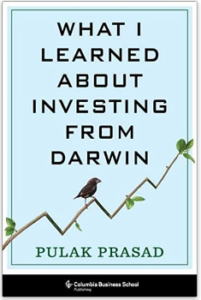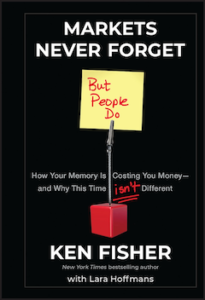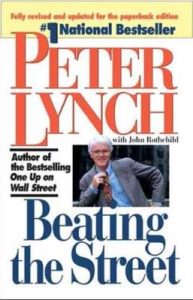Perhaps the biggest awakening I have had as a professional investor is that our job as investment managers does not stop at finding outstanding companies – and making sure they stay outstanding over time. If we want to serve our investors well, we need to educate them on why we invest the way we do (because it is what we believe works best), and what it takes to realize one’s dreams in the stock market (patience and fortitude). Our investors, who these days approach seventy individuals, families, and institutions, need to not only feel comfortable that we know what we are doing and that we are going to continue doing our job well, but sometimes they need help with how they think about their objectives. Are they really long-term investors? Do they really believe in the future? What can we do or say to make them feel more comfortable that history is on their side?
I am not alone in drawing inspiration from Warren Buffett, even if he is no fan of investment managers like ourselves, who charge fees for our services. It is hard to disagree with Buffett’s assertions that most professional money managers don’t add value, but that is precisely what has drawn me to this business and compelled me to start our firm eight years ago. Buffett himself is proof that it is possible for a money manager to make people’s dreams come true, and he is certainly not the only one who has done it. While he is undoubtedly a talented investor, it was not only his investing that made dreams come true, but his talents as a communicator and his ability to inspire trust, comfort and, most importantly, the belief in a better future.
Towards the end of his latest letter, dated February 26, 2022, Buffett explains what really enabled so many of his investors to realize their dreams. His shareholders often acknowledge that “Berkshire might be far from the best selection they could have made. But they would add that Berkshire would rank high among those with which they would be most comfortable. And people who are comfortable with their investments will, on average, achieve better results than those who are motivated by ever-changing headlines, chatter and promises.” I cannot emphasize enough the impact that this statement made on me as I read it the day his letter was published. Sure, people can invest on their own or they can buy ETFs or large funds that charge discounted fees, but can they get the degree of comfort that enables them to stay the course when the going gets tough? Some people can do that, but most cannot. Having a manager who is credible, transparent, consistent, and devoted to keeping it simple, goes a long way in helping people achieve their dreams.
It is not only individuals and families that require trust and comfort to stick with their investments for the long-term. Sophisticated institutional investors, plan sponsors, wealth managers, and fund allocators, have just as much (and sometimes even more) need for transparency and information about what their managers are doing and thinking. This is the reason we consider our letters, webinars, and other communication efforts so fundamental to our job, even if they do add an extra workload. But technical information on companies is not enough to make a good investor. Many investors fail to make their dreams come true because of behavioral biases. Even when they understand what it takes to make it to dreamland, they still succumb to fear and despair by hitting the sell button, often near bottoms, and often with scars that keep them from ever coming back in. Allow me to illustrate some of these behaviors by using the stories of Bob, Faust and Ms. Groner.
Bob’s story comes from this 2014 article by Ben Carlson. Bob is a fictional character who began his career in 1970 at age 22. He saved $2,000 a year during the 1970s and bumped the amount up by $2,000 each decade until he could retire at age 65 in 2013. He tucked away $4,000/year in the 80s, $6,000/year in the 90s, and $8,000/year until he retired. Bob’s problem was that he only had the courage to put his money to work in the market after a huge run-up. So the first three years of his savings ($6,000) went into an S&P 500 index fund at the end of 1972, right before the market dropped nearly 50% in 1973-74. Bob didn’t feel comfortable about investing again until August of 1987, after another huge bull market. After 15 years of saving he had $46,000 in cash to put to work. He invested this money again into the S&P 500 at a market peak, before it lost more than 30%. After the 1987 crash, Bob didn’t feel right about putting his future savings back into stocks until the tech bubble really ramped up at the end of 1999. He had accumulated $68,000 of cash this time, which he put to work at the end of December in 1999, just before a 50% drop that lasted until 2002. After being burned again, Bob saved in cash until October of 2007, when he finally decided to invest the $64,000 he had accumulated since 2000. He bought just before another 50% crash, after which he decided to continue to save his money in the bank until retiring in 2013 (another $40,000).
It is important to note that even after each crash Bob did not sell out of the market – he just did not invest more. So, while Bob couldn’t time his buys, he still ended up with $1.1 million upon his retirement at 65. Despite being a terrible market timer, Bob is a success story because he saved more than he spent, and he invested those savings into the stock market. Had Bob simply dollar cost averaged into the market on an annual basis with his earned savings, though, he would have ended up twice as rich. Bob’s story is rare because very few people would have refrained from selling after such traumatic experiences. Had Bob found an investment manager he trusted, and who educated him on the nature of the companies he was investing in (like Warren Buffett does so well), instead of just “the market,” then maybe Bob’s dreams would have come true in a much bigger way.
Now consider the story of Faust, another fictional, though highly representative character. He was terrified of bear markets, so he found himself out of the market whenever stocks turned lower. His belief was that he did not need to be invested when the trend was downward, so he always sold out when his account was down more than 20% and he required that “the market” demonstrate that it had bottomed before he jumped back in on the other side. This mentality practically ensured that he missed out on the biggest up moves, which typically happen when the outlook is bleakest and the market runs out of sellers.
Faust’s story was inspired by Todd Petzel’s book, Modern Portfolio Management (2021), which illustrates what tends to happen to people who behave like Faust. Petzel shares a chart in Chapter 4 showing how from 1988 to Q1-2019, the S&P 500 compounded at an annual rate of 10.3%, but when one removes the best day from each year from the series, the compounding rate drops to 6.4%. Unless they are extremely lucky or great market timers, an investor acting on such a Faustian mentality likely received an even lower return on an after-tax basis.
Now let’s review the true story of Ms. Groner, which Todd Petzel recounts in his book, and which is like the stories that Thomas Phelps tells in my favorite book, 100 to 1 in the Stock Market (1972). As disclosed in a March 2010 article in the Chicago Tribune (link), Ms. Groner was a career secretary at Abbott Labs who purchased three shares of the company for $180 in 1935, when she was 25 years old. Over the subsequent 75 years, and after many splits and reinvested dividends, her three shares turned into $7 million, which was all donated to Lake Forest College upon her death at 100 in 2010. While that seems amazing, the appreciation comes out to a fairly reasonable annualized rate of return of 15%. Had she not donated the money and her family kept it invested in Abbott stock after her death, her stake would be worth nearly $34 million today – 12 years later, since Abbott has continued to compound in the mid-teens. It is no wonder that when Fidelity did a study to determine the profile of the best performing accounts on their platform (link), they discovered that those accounts were the ones that belonged to dead people.
Of course the investors that do worst are the ones who think like Bob in bull markets and then turn into Faust in bear markets. Not only do they systematically buy near the top, they also sell near the bottom. Sadly, according to some studies (including those done by Fidelity), this describes most individual investors. It also happens that many financial advisors, whose job is to keep their clients from behaving this way, end up doing the same out of fear of being fired, or some other conflict of interest. The solution, in my opinion, is to adopt a long–term mentality that is grounded on a simple concept: let the outstanding companies out there work for us. It is critical that our investors know that they are not investing in “the market”, and that we are behaving neither like Bob nor Faust. Like Warren Buffett and Charlie Munger, our investors are allocating their capital to outstanding managements running outstanding businesses that stand a good chance of remaining outstanding for decades, regardless of the market. As such, while Bob and Faust might manage to accumulate some wealth if they save more than they earn, our investors stand a chance of doing much better than that. That’s what we mean by making dreams come true.










